Zinc Oxide-Based Self-Powered Potentiometric Chemical Sensors for Biomolecules and Metal Ions
Abstract
:1. Introduction
2. Growth of ZnO Nanostructures
3. Chemical Sensors
4. Enzyme Immobilized ZnO-Based Biosensors
5. Cholesterol Sensors
6. Glucose Sensors
7. Ionophore Immobilized ZnO Based Sensors
8. Zinc Ion Sensors
9. Magnesium Ion Sensors
10. Calcium Sensors
11. Concluding Remarks
Author Contributions
Conflicts of Interest
References
- Wang, Z.L. Triboelectric Nanogenerators as New Energy Technology for Self-Powered Systems and as Active Mechanical and Chemical Sensors. ACS Nano 2013, 7, 9533–9557. [Google Scholar] [CrossRef] [PubMed]
- Chen, S.W.; Wang, N.; Ma, L.; Li, T.; Willander, M.; Jie, Y.; Cao, X.; Wang, Z.L. Triboelectric Nanogenerator for Sustainable Wastewater Treatment via a Self-Powered Electrochemical Process. Adv. Energy Mater. 2016, 6. [Google Scholar] [CrossRef]
- Zhu, H.R.; Wang, N.; Xu, Y.; Chen, S.W.; Willander, M.; Cao, X.; Wang, Z.L. Triboelectric Nanogenerators Based on Melamine and Self-Powered High-Sensitive Sensors for Melamine Detection. Adv. Funct. Mater. 2016, 26, 3029–3035. [Google Scholar] [CrossRef]
- Park, J.; Lee, Y.; Ha, M.; Cho, S.; Ko, H. Micro/nanostructured surfaces for self-powered and multifunctional electronic skins. J. Mater. Chem. B 2016, 4, 2999–3018. [Google Scholar] [CrossRef]
- Yang, Y.; Zhang, H.L.; Chen, J.; Lee, S.M.; Hou, T.C.; Wang, Z.L. Simultaneously harvesting mechanical and chemical energies by a hybrid cell for self-powered biosensors and personal electronics. Energy Environ. Sci. 2013, 6, 1744–1749. [Google Scholar] [CrossRef]
- Moo, J.G.S.; Pumera, M. Chemical Energy Powered Nano/Micro/Macromotors and the Environment. Chem. A Eur. J. 2015, 21, 58–72. [Google Scholar] [CrossRef] [PubMed]
- Solanki, P.R.; Kaushik, A.; Agrawal, V.V.; Malhotra, B.D. Nanostructured metal oxide-based biosensors. NPG Asia Mater. 2011, 3, 17–24. [Google Scholar] [CrossRef]
- Willander, M.; Yang, L.L.; Wadeasa, A.; Ali, S.U.; Asif, M.H.; Zhao, Q.X.; Nur, O. Zinc oxide nanowires: Controlled low temperature growth and some electrochemical and optical nano-devices. J. Mater. Chem. 2009, 19, 1006–1018. [Google Scholar] [CrossRef]
- Imran, M.; Haider, S.; Ahmad, K.; Mahmood, A.; Al-Masry, W.A. Fabrication and characterization of zinc oxide nanofibers for renewable energy applications. Arab. J. Chem. 2017, 10, S1067–S1072. [Google Scholar] [CrossRef]
- Singh, S.P.; Arya, S.K.; Pandey, P.; Malhotra, B.D.; Saha, S.; Sreenivas, K.; Gupta, V. Cholesterol biosensor based on rf sputtered zinc oxide nanoporous thin film. Appl. Phys. Lett. 2007, 91, 063901. [Google Scholar] [CrossRef]
- Lloyd, J.S.; Fung, C.M.; Deganello, D.; Wang, R.J.; Maffeis, T.G.G.; Lau, S.P.; Teng, K.S. Flexographic printing-assisted fabrication of ZnO nanowire devices. Nanotechnology 2013, 24, 195602. [Google Scholar] [CrossRef] [PubMed]
- Isakov, I.; Panfilova, M.; Sourribes, M.J.L.; Warburton, P.A. Growth of ZnO and ZnMgO nanowires by Au-catalysed molecular-beam epitaxy. Phys. Status Solidi C Curr. Top. Solid State Phys. 2013, 10, 1308–1313. [Google Scholar] [CrossRef]
- Santiago, K.; Mundle, R.; Samantaray, C.B.; Bahoura, M.; Pradhan, A.K. Nanopatterning of atomic layer deposited Al:ZnO films using electron beam lithography for waveguide applications in the NIR region. Opt. Mater. Express 2012, 2, 1743–1750. [Google Scholar] [CrossRef]
- Israr, M.Q.; Sadaf, J.R.; Yang, L.L.; Nur, O.; Willander, M.; Palisaitis, J.; Persson, P.O.A. Trimming of aqueous chemically grown ZnO nanorods into ZnO nanotubes and their comparative optical properties. Appl. Phys. Lett. 2009, 95, 073114. [Google Scholar] [CrossRef]
- Israr-Qadir, M.; Jamil-Rana, S.; Nur, O.; Willander, M.; Larsson, L.A.; Holtz, P.O. Fabrication of ZnO nanodisks from structural transformation of ZnO nanorods through natural oxidation and their emission characteristics. Ceram. Int. 2014, 40, 2435–2439. [Google Scholar] [CrossRef]
- Israr-Qadir, M.; Jamil-Rana, S.; Nur, O.; Willander, M.; Lu, J.; Hultman, L. Cathodoluminescence characterization of ZnO nanorods synthesized by chemical solution and of its conversion to ellipsoidal morphology. J. Mater. Res. 2014, 29, 2425–2431. [Google Scholar] [CrossRef]
- Staels, B. Cardiovascular biology—A cholesterol tether. Nature 2002, 417, 699–701. [Google Scholar] [CrossRef] [PubMed]
- Nauck, M.; Marz, W.; Wieland, H. Is lipoprotein(a) cholesterol a significant indicator of cardiovascular risk? Clin. Chem. 2000, 46, 436–437. [Google Scholar] [PubMed]
- Martin, S.P.; Lamb, D.J.; Lynch, J.M.; Reddy, S.M. Enzyme-based determination of cholesterol using the quartz crystal acoustic wave sensor. Anal. Chim. Acta 2003, 487, 91–100. [Google Scholar] [CrossRef]
- Ikonen, E. Cellular cholesterol trafficking and compartmentalization. Nat. Rev. Mol. Cell Biol. 2008, 9, 125–138. [Google Scholar] [CrossRef] [PubMed]
- Isaccsohn, J. Yale University School of Medicine Heart Book; Hearst Books: New York, NY, USA, 1992. [Google Scholar]
- Israr, M.Q.; Sadaf, J.R.; Engquist, I.; Nour, O.; Willander, M.; Danielsson, B. Structural characterization and biocompatible applications of graphene nanosheets for miniaturization of potentiometric cholesterol biosensor. J. Biosens. Bioelectron. 2011, 2. [Google Scholar] [CrossRef]
- Israr, M.Q.; Sadaf, J.R.; Asif, M.H.; Nur, O.; Willander, M.; Danielsson, B. Potentiometric cholesterol biosensor based on ZnO nanorods chemically grown on Ag wire. Thin Solid Films 2010, 519, 1106–1109. [Google Scholar] [CrossRef]
- Jamil-Rana, S.; Israr-Qadir, M.; Nur, O.; Willander, M. Naturally oxidized synthesis of ZnO dahlia-flower nanoarchitecture. Ceram. Int. 2014, 40, 13667–13671. [Google Scholar] [CrossRef]
- Israr, M.Q.; Sadaf, J.R.; Nur, O.; Willander, M.; Salman, S.; Danielsson, B. Chemically fashioned ZnO nanowalls and their potential application for potentiometric cholesterol biosensor. Appl. Phys. Lett. 2011, 98, 253705. [Google Scholar] [CrossRef]
- Kumar, A.; Malhotra, R.; Malhotra, B.D.; Grover, S.K. Co-immobilization of cholesterol oxidase and horseradish peroxidase in a sol–gel film. Anal. Chim. Acta 2000, 414, 43–50. [Google Scholar] [CrossRef]
- Raghavan, V.; Ramanathan, K.; Sundaram, P.V.; Danielsson, B. An enzyme thermistor-based assay for total and free cholesterol. Clin. Chim. Acta 1999, 289, 145–158. [Google Scholar] [CrossRef]
- Wu, X.J.; Choi, M.M.F. Hydrogel network entrapping cholesterol oxidase and octadecylsilica for optical biosensing in hydrophobic organic or aqueous micelle solvents. Anal. Chem. 2003, 75, 4019–4027. [Google Scholar] [CrossRef] [PubMed]
- Kumar, A.; Suman. Cholesterol Biosensor Based on Polyvinyl Formal Membrane Bound Cholesterol Esterase and Oxidase. Sens. Transducers J. 2007, 83, 1555–1563. [Google Scholar]
- Basu, A.K.; Chattopadhyay, P.; Roychoudhuri, U.; Chakraborty, R. Development of cholesterol biosensor based on immobilized cholesterol esterase and cholesterol oxidase on oxygen electrode for the determination of total cholesterol in food samples. Bioelectrochemistry 2007, 70, 375–379. [Google Scholar] [CrossRef] [PubMed]
- Solanki, P.R.; Singh, S.; Prabhakar, N.; Panday, M.K.; Malhotra, B.D. Application of conducting poly(aniline-co-pyrrole) film to cholesterol biosensor. J. Appl. Polym. Sci. 2007, 105, 3211–3219. [Google Scholar] [CrossRef]
- Vidal, J.C.; Espuelas, J.; Castillo, J.R. Amperometric cholesterol biosensor based on in situ reconstituted cholesterol oxidase on an immobilized monolayer of flavin adenine dinucleotide cofactor. Anal. Biochem. 2004, 333, 88–98. [Google Scholar] [CrossRef] [PubMed]
- Umar, A.; Rahman, M. M.; Al-Hajry, A.; Hahn, Y. B. Highly-sensitive cholesterol biosensor based on well-crystallized flower-shaped ZnO nanostructures. Talanta 2009, 78, 284–289. [Google Scholar] [CrossRef] [PubMed]
- Ibupoto, Z.H.; Elhag, S.; Nur, O.; Willander, M. Fabrication of sensitive potentiometric cholesterol biosensor based on Co3O4 interconnected nanowires. Electroanalysis 2014, 26, 1928–1934. [Google Scholar] [CrossRef]
- Fulati, A.; Ali, S.M.U.; Asif, M.H.; Alvi, N.U.; Willander, M.; Brannmark, C.; Stralfors, P.; Borjesson, S.I.; Elinder, F.; Danielsson, B. An intracellular glucose biosensor based on nanoflake ZnO. Sens. Actuators B Chem. 2010, 150, 673–680. [Google Scholar] [CrossRef]
- Ali, S.M.U.; Nur, O.; Willander, M.; Danielsson, B. A fast and sensitive potentiometric glucose microsensor based on glucose oxidase coated ZnO nanowires grown on a thin silver wire. Sens. Actuators B Chem. 2010, 145, 869–874. [Google Scholar]
- Abe, T.; Lau, Y.Y.; Ewing, A.G. Characterization of Glucose Microsensors for Intracellular Measurements. Anal. Chem. 1992, 64, 2160–2163. [Google Scholar] [CrossRef] [PubMed]
- Asif, M.H.; Ali, S.M.U.; Nur, O.; Willander, M.; Brannmark, C.; Stralfors, P.; Englund, U.H.; Elinder, F.; Danielsson, B. Functionalised ZnO-nanorod-based selective electrochemical sensor for intracellular glucose. Biosens. Bioelectron. 2010, 25, 2205–2211. [Google Scholar] [CrossRef] [PubMed]
- Cline, G.W.; Jucker, B.M.; Trajanoski, Z.; Rennings, A.J.M.; Shulman, G.I. A novel C-13 NMR method to assess intracellular glucose concentration in muscle, in vivo. Am. J. Physiol. Endocrinol. Metab. 1998, 274, E381–E389. [Google Scholar]
- Fraústo Da Silva, J.J.R.; Williams, R.J.P. The Biological Chemistry of the Elements, 2nd ed.; Oxford University Press: New York, NY, USA, 2001. [Google Scholar]
- Asif, M.H.; Willander, M.; Stralfors, P.; Danielsson, B. Nanotechnology and Nanomedicine in Diabetes; Preedy Science Publishers, CRC: London, UK, 2012. [Google Scholar]
- Asif, M.H.; Fulati, A.; Nur, O.; Willander, M.; Brannmark, C.; Stralfors, P.; Borjesson, S.I.; Elinder, F. Functionalized zinc oxide nanorod with ionophore-membrane coating as an intracellular Ca2+ selective sensor. Appl. Phys. Lett. 2009, 95, 023703. [Google Scholar] [CrossRef]
- Asif, M.H.; Nur, O.; Willander, M.; Yakovleva, M.; Danielsson, B. Studies on calcium ion selectivity of ZnO nanorwires sensors using ionophore membrane coatings. Res. Lett. Nanotechnol. 2008, 2008, 701813. [Google Scholar] [CrossRef]
- Patolsky, F.; Lieber, C.M. Nanowire nanosensors. Mater. Today 2005, 8, 20–28. [Google Scholar] [CrossRef]
- Hodgkin, A.L.; Katz, B. The effect of sodium ions on teh electrical activity of the giant axon of the squid. J. Physiol. 1949, 108, 37–77. [Google Scholar] [CrossRef] [PubMed]
- McDonough, A.A. Mechanisms of proximal tubule sodium transport regulation that link extracellular fluid volume and blood pressure. Am. J. Physiol. Regul. Integr. Comp. Physiol. 2010, 298, R851–R861. [Google Scholar] [CrossRef] [PubMed]
- Elinder, F.; Arhem, P. Metal ion effects on ion channel gating. Q. Rev. Biophys. 2003, 36, 373–427. [Google Scholar] [CrossRef] [PubMed]
- Ibupoto, Z.H.; Ali, S.M.U.; Chey, C.O.; Khun, K.; Nur, O.; Willander, M. Selective zinc ion detection by functionalised ZnO nanorods with ionophore. J. Appl. Phys. 2011, 110, 104702. [Google Scholar] [CrossRef]
- Fulati, A.; Ali, S.M.U.; Riaz, M.; Amin, G.; Nur, O.; Willander, M. Miniaturized pH Sensors Based on Zinc Oxide Nanotubes/Nanorods. Sensors 2009, 9, 8911–8923. [Google Scholar] [CrossRef] [PubMed]
- Kuschinsky, W.; Wahl, M.; Bosse, O.; Thurau, K. Pervascular potassium and pH as determinants of local pial arterial diameter in cats. Circ. Res. 1972, 31, 240–247. [Google Scholar] [CrossRef] [PubMed]
- Hille, B. Ion Channels of Excitable Membranes, 3rd ed.; Sinauer Associates: Sunderland, MA, USA, 2001. [Google Scholar]
- Asif, M.H.; Ali, S.M.U.; Nur, O.; Willander, M.; Englund, U.H.; Elinder, F. Functionalized ZnO nanorod-based selective magnesium ion sensor for intracellular measurements. Biosens. Bioelectron. 2010, 26, 1118–1123. [Google Scholar] [CrossRef] [PubMed]
- Al-Hilli, S.M.; Willander, M.; Ost, A.; Stralfors, P. ZnO nanorods as an intracellular sensor for pH measurements. J. Appl. Phys. 2007, 102, 084304. [Google Scholar] [CrossRef]
- Danielsson, A.; Ost, A.; Lystedt, E.; Kjolhede, P.; Gustavsson, J.; Nystrom, F.H.; Stralfors, P. Insulin resistance in human adipocytes occurs downstream of IRS1 after surgical cell isolation but at the level of phosphorylation of IRS1 in type 2 diabetes. FEBS J. 2005, 272, 141–151. [Google Scholar] [CrossRef] [PubMed]
- Stralfors, P.; Honnor, R.C. Insulin-Induced Dephosphorylation of Hormone-Sensitive Lipase-Correlation with Lipolysis and Camp-Dependent Protein-Kinase Activity. Eur. J. Biochem. 1989, 182, 379–385. [Google Scholar] [CrossRef] [PubMed]
- Asif, M.H.; Nur, O.; Willander, M.; Stralfors, P.; Brannmark, C.; Elinder, F.; Englund, U.H.; Lu, J.; Hultman, L. Growth and Structure of ZnO Nanorods on a Sub-Micrometer Glass Pipette and Their Application as Intracellular Potentiometric Selective Ion Sensors. Materials 2010, 3, 4657–4667. [Google Scholar] [CrossRef]
- Ali, S.M.U.; Asif, M.H.; Fulati, A.; Nur, O.; Willander, M.; Brannmark, C.; Stralfors, P.; Englund, U.H.; Elinder, F.; Danielsson, B. Intracellular K+ Determination With a Potentiometric Microelectrode Based on ZnO Nanowires. IEEE Trans. Nanotechnol. 2011, 10, 913–919. [Google Scholar] [CrossRef]
- Berridge, M.J.; Bootman, M.D.; Roderick, H.L. Calcium signalling: Dynamics, homeostasis and remodelling. Nat. Rev. Mol. Cell Biol. 2003, 4, 517–529. [Google Scholar] [CrossRef] [PubMed] [Green Version]
- Takahashi, T.; Neher, E.; Sakmann, B. Rat-Brain Serotonin Receptors in Xenopus Oocytes Are Coupled by Intracellular Calcium to Endogenous Channels. Proc. Natl. Acad. Sci. USA 1987, 84, 5063–5067. [Google Scholar] [CrossRef] [PubMed]
- Draznin, B.; Sussman, K.E.; Eckel, R.H.; Kao, M.; Yost, T.; Sherman, N.A. Possible Role of Cytosolic Free Calcium Concentrations in Mediating Insulin Resistance of Obesity and Hyperinsulinemia. J. Clin. Investig. 1988, 82, 1848–1852. [Google Scholar] [CrossRef] [PubMed]
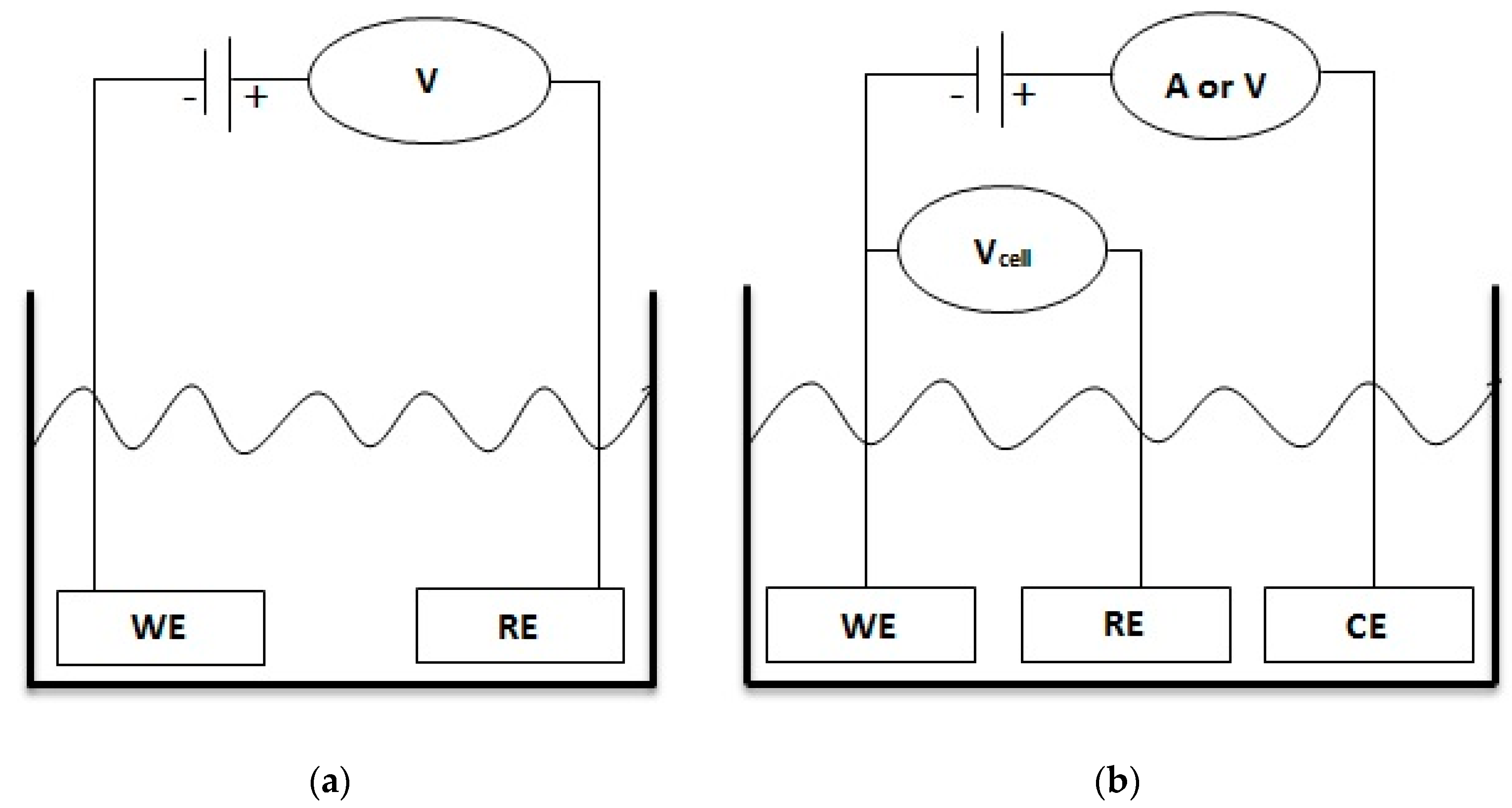

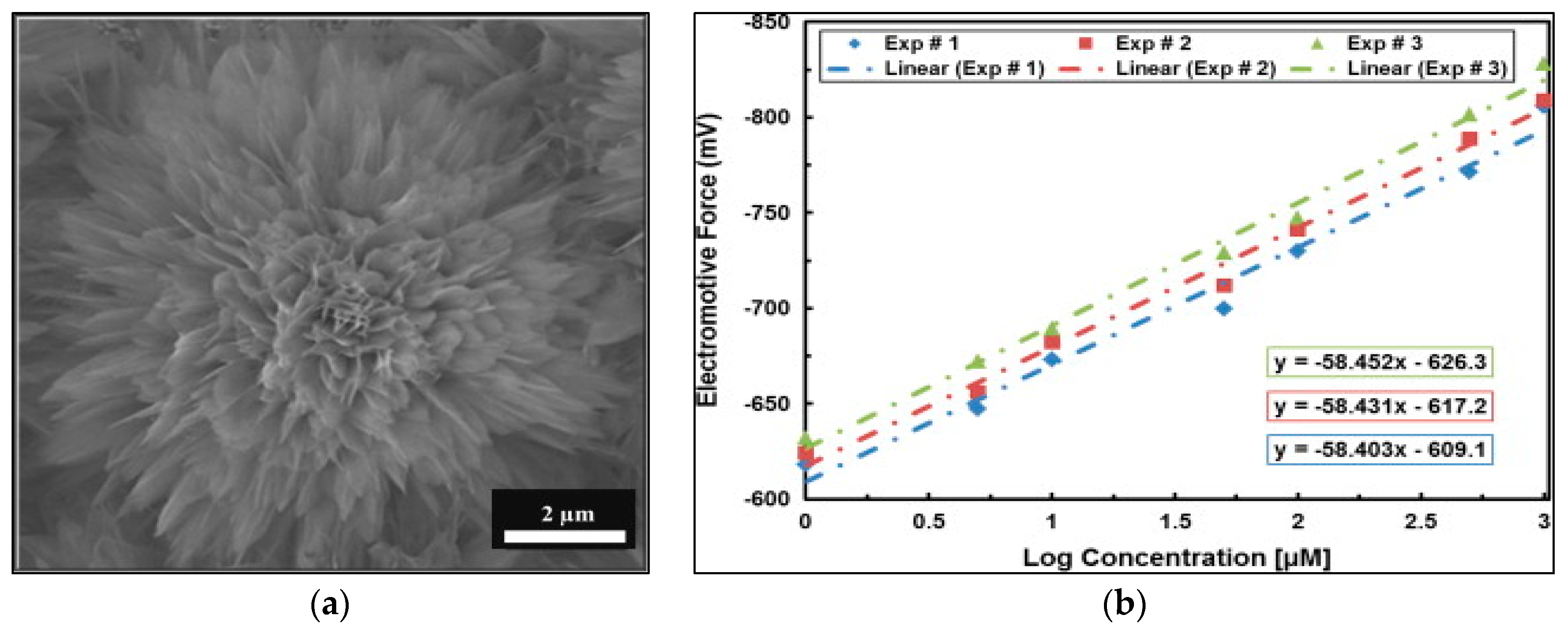
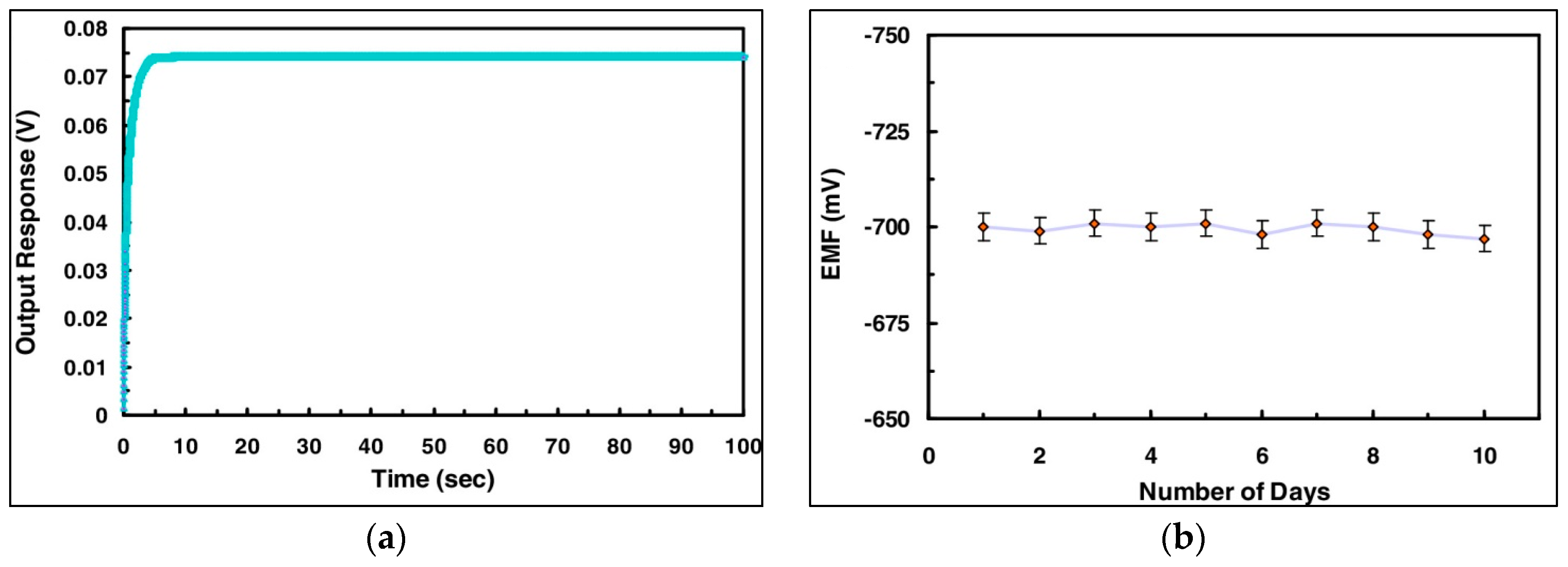

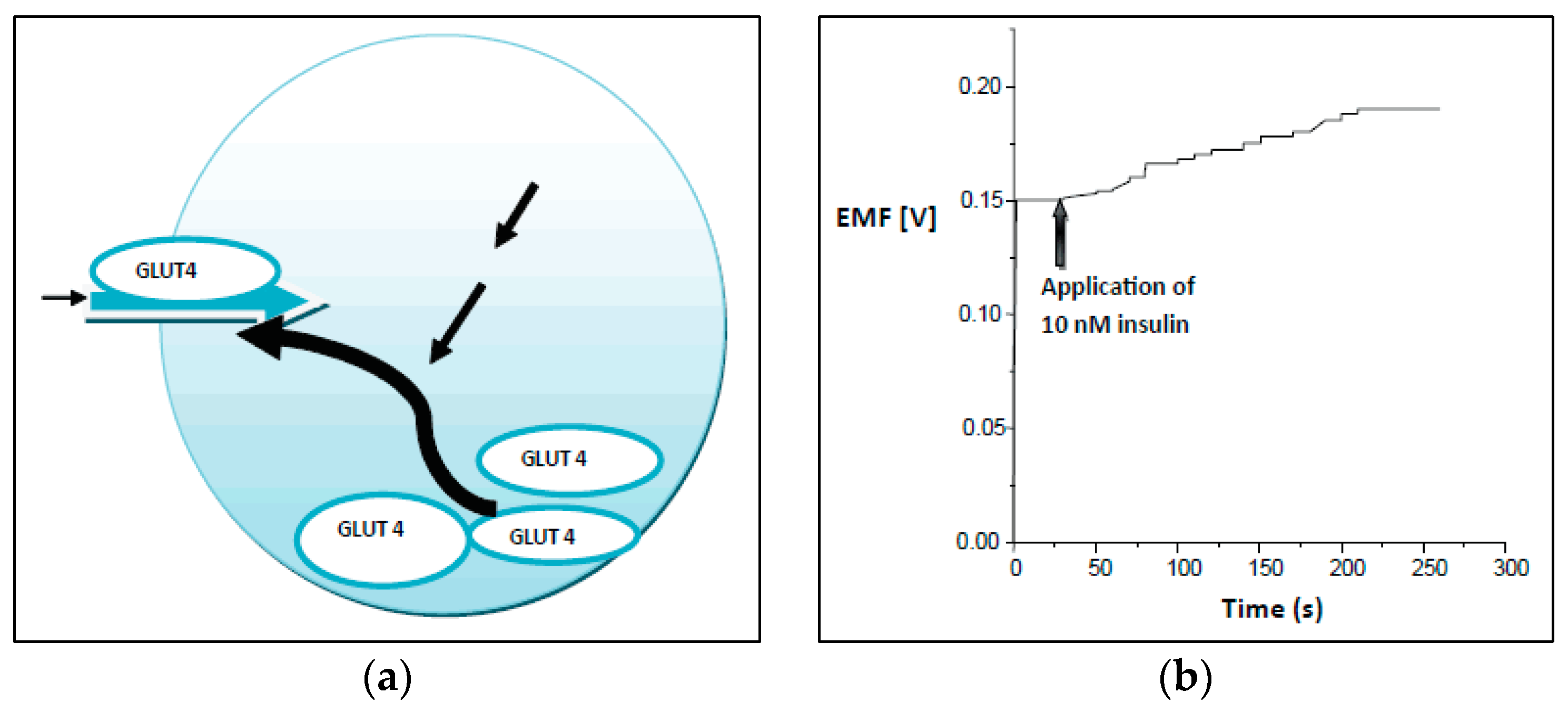
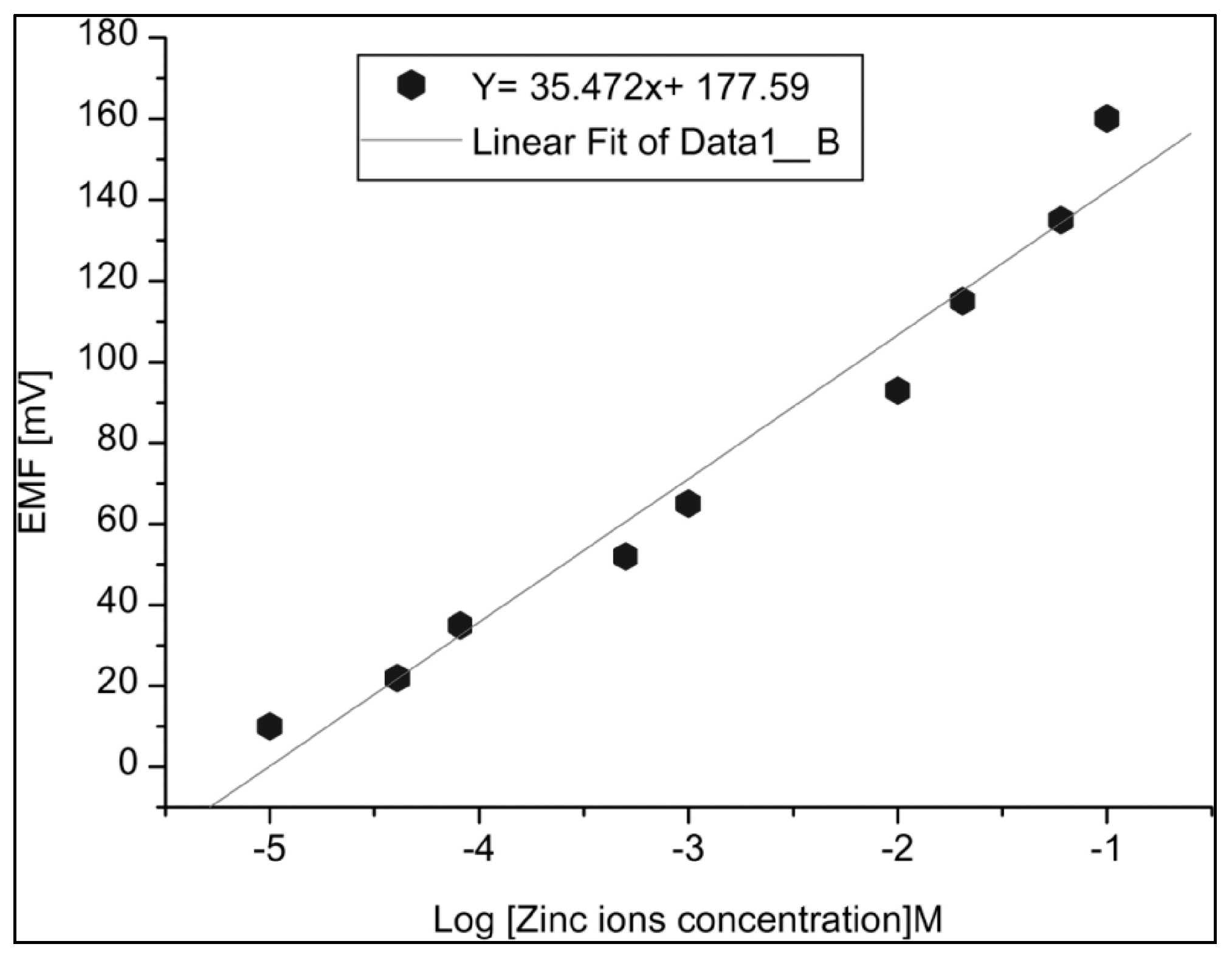
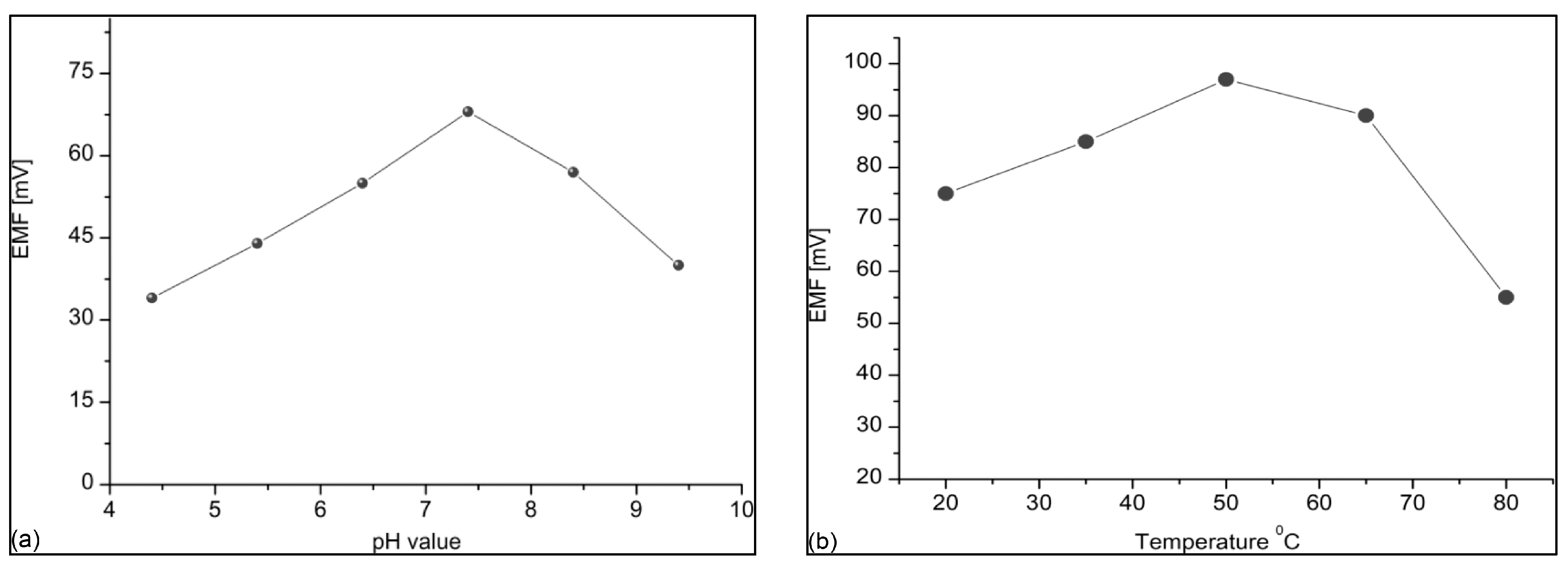
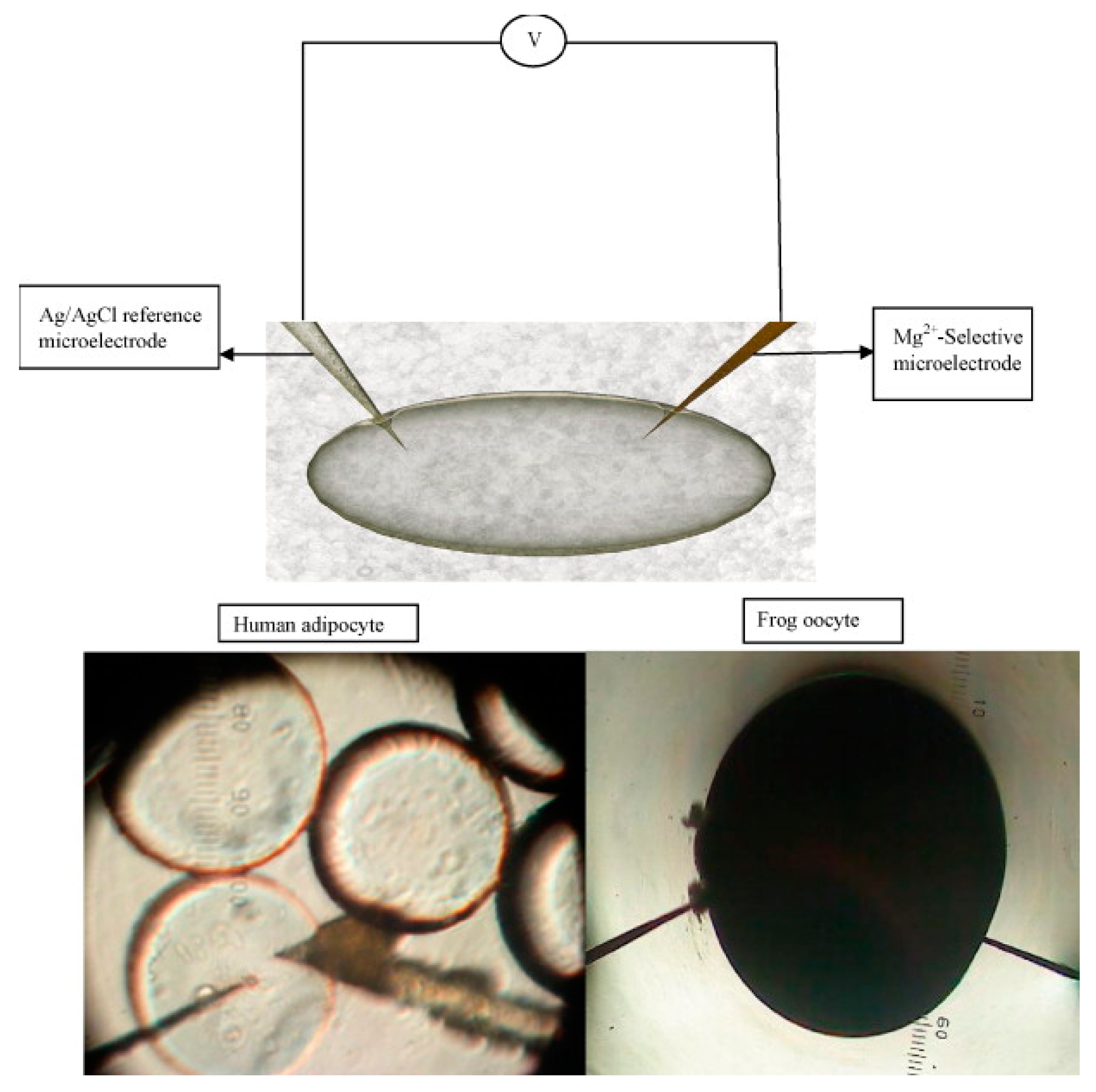
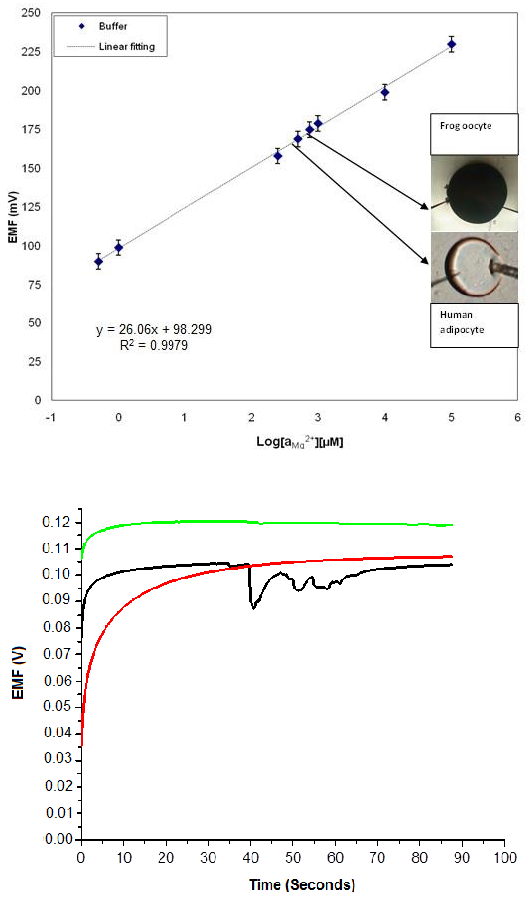
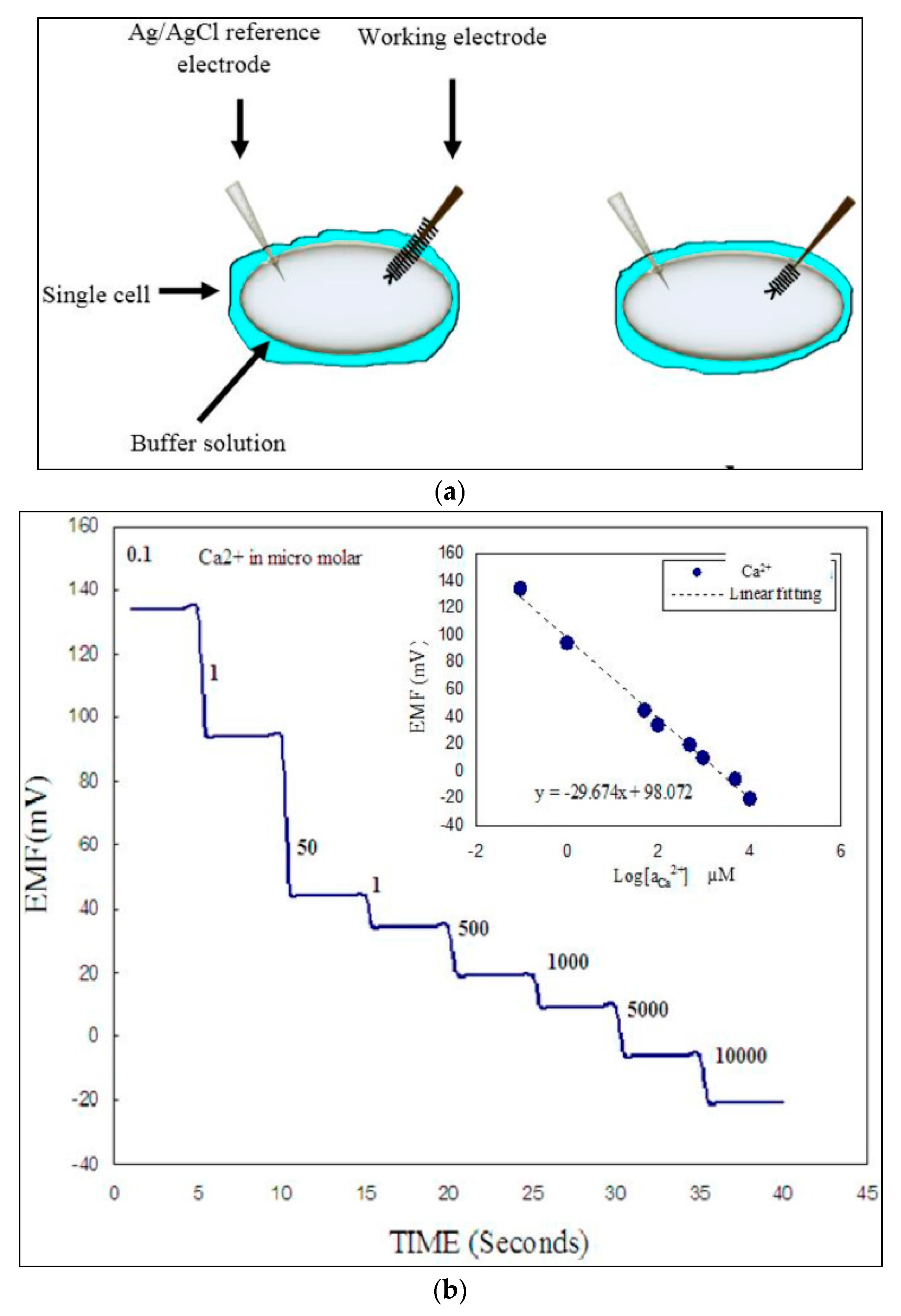
| Materials | ISE Point | Important Features | Target Molecules |
|---|---|---|---|
| TiO2 | 3.9–8.2 | Biocompatible, photocatalysis | ChOx, Urs, DNA, IgG |
| V2O5 | 3.0 | Catalysis | DNA |
| SnO2 | 4.5–5.0 | Low working potential, electron transfer | ChOx, GOx, DNA, IgG |
| Fe3O4 | 8.4–8.5 | Superparamagnetism with O2 atoms of proteins | ChOx, GOx, Urs, DNA |
| SiO2 | 1.7–3.0 | Biocompatible, functional | ChOx, GOx, DNA, IgG |
| CuO | 9.5 | Multi-electron oxidation | IgG |
| CeO2 | 6.7–9.5 | Biocompatible, fast electron transfer | ChOx, Urs, DNA, IgG |
| ZnO | 9.5 | Biocompatible, fast electron transfer, non-toxic, diverse nanomorphologies | ChOx, GOx, Urs, DNA, MIOs, IgG |
| Category | Matrix | Sensitivity | Respnse Time | Self-Life |
|---|---|---|---|---|
| EPCS | Tetraethylorthosilcate | – | 15 s | 8 weeks |
| EPCS | Controlled pore glass | 0.1 mM | 2 min | 12 months |
| EPCS | Octadecyl silica | – | 7–12 min | 8 weeks |
| EPCS | Polyvinyl membrane/oxygen electrode | – | – | 20 days |
| EPCS | BSA/polycarbonate/oxygen electrode | – | 90 s | 8 weeks |
| EPCS | Poly(aniline-co-pyrrole)/ITO | 93.35 nA μM−1 | – | 10 weeks |
| EPCS | Cystamine | 625.5 nA mM−1 | 3 s | 5 days |
| EPCS | ZnO nanostructures | 61.7 µA µM−1 cm−2 | – | 32 days |
| SPCS | ZnO nanowalls | 53 mV/decade | 5 s | 3 weeks |
| SPCS | ZnO nanorods | 35.2 mV/decade | 10 s | 12 weeks |
| SPCS | Co3O4 nanowires | −94 mV/decade | 10 s | – |
© 2017 by the authors. Licensee MDPI, Basel, Switzerland. This article is an open access article distributed under the terms and conditions of the Creative Commons Attribution (CC BY) license (http://creativecommons.org/licenses/by/4.0/).
Share and Cite
Israr-Qadir, M.; Jamil-Rana, S.; Nur, O.; Willander, M. Zinc Oxide-Based Self-Powered Potentiometric Chemical Sensors for Biomolecules and Metal Ions. Sensors 2017, 17, 1645. https://doi.org/10.3390/s17071645
Israr-Qadir M, Jamil-Rana S, Nur O, Willander M. Zinc Oxide-Based Self-Powered Potentiometric Chemical Sensors for Biomolecules and Metal Ions. Sensors. 2017; 17(7):1645. https://doi.org/10.3390/s17071645
Chicago/Turabian StyleIsrar-Qadir, Muhammad, Sadaf Jamil-Rana, Omer Nur, and Magnus Willander. 2017. "Zinc Oxide-Based Self-Powered Potentiometric Chemical Sensors for Biomolecules and Metal Ions" Sensors 17, no. 7: 1645. https://doi.org/10.3390/s17071645




